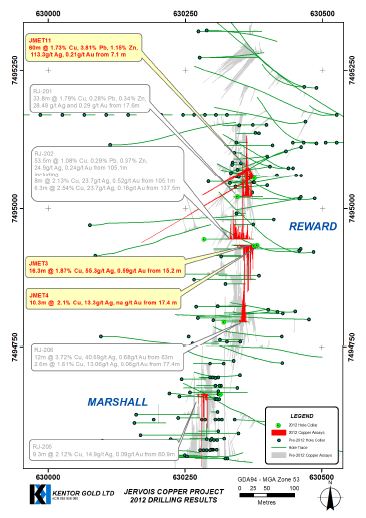Kentor hits high-grade gold at Jervois
THE DRILL SERGEANT: Kentor Gold has reported a raft of high-grade, near surface drill results from a drilling program at the company’s Jervois copper-silver-gold project in the Northern Territory.
The results returned assays of up to 19.4 per cent copper, 37.6 per cent lead, 14.2 per cent zinc and 702 grams per tonne silver.
Drilling results included:
– 60 metres at 1.73 per cent copper, 3.81 per cent lead, 1.15 per cent zinc, 113.3g/t silver, 0.21g/t gold from 7.1 metres, including 12.06 per cent copper, 2.42 per cent lead, 2.4 per cent zinc, 217.3 g/t silver and 0.62g/t gold in the first 3.35 metres.
– 16.3m at 1.87 per cent copper, 55.3g/t silver and 0.59g/t gold from 15.2m; and
– 10.3m at 2.1 per cent copper and 13.3g/t silver from 17.4 m.
The drilling is part of a feasibility study Kentor is undertaking to follow up a recently completed scoping study, which found Jervois would be a robust project capable of producing strong financial returns.

Source: Company announcement
“These significant, near-surface results continue to confirm the open pit mining potential of the Jervois project,” Kentor Gold managing director Simon Milroy said in the company’s announcement to the Australian Securities Exchange.
“The high grade multi-metal results include good gold grades, strengthening the expectation that we will be able to include gold for the first time in an increased Mineral Resource.”
Kentor indicated the metallurgical drilling it is undertaking at the Jervois project continues to indicate significant mineralisation in targeted areas.
Of the planned 5,459m of diamond drilling, Kentor has now completed 4,179m.
The remaining six diamond tails totalling 1,280m are anticipated to be completed by mid-July.
The company is also nearing completion of a 10,000m RC drilling program with the remaining 11 holes to be drilled this month.
All thirteen metallurgical diamond holes have been delivered to a Perth laboratory where comminution test work and analysis has commenced.
The company said this would build on results it had received from three holes analysed in its earlier test work programs.




